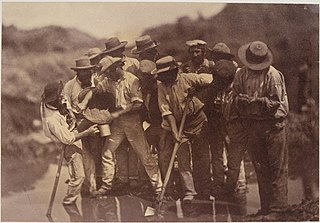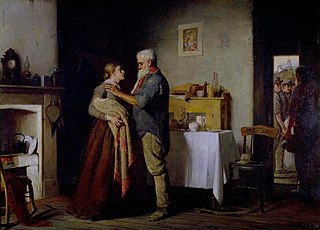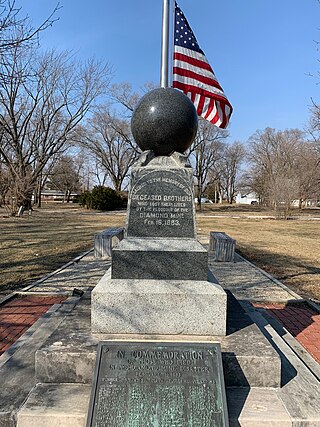Related Research Articles

HMVS Cerberus is a breastwork monitor that served in the Victoria Naval Forces, the Commonwealth Naval Forces (CNF), and the Royal Australian Navy (RAN) between 1871 and 1924.

The Victorian gold rush was a period in the history of Victoria, Australia approximately between 1851 and the late 1860s. It led to a period of extreme prosperity for the Australian colony, and an influx of population growth and financial capital for Melbourne, which was dubbed "Marvellous Melbourne" as a result of the procurement of wealth.
Beaconsfield is a former gold mining town near the Tamar River, in the north-east of Tasmania, Australia. It lies 40 kilometres north of Launceston on the West Tamar Highway. It is a rural and residential locality in the local government areas (LGA) of West Tamar and Latrobe in the Launceston and North-west and west LGA regions of Tasmania. The 2016 census has a population of 1298 for the state suburb of Beaconsfield.

Sovereign Hill is an open-air museum in Golden Point, a suburb of Ballarat, Victoria, Australia. Sovereign Hill depicts Ballarat's first ten years after the discovery of gold there in 1851. It was officially opened on 29 November 1970 and has become a nationally acclaimed tourist attraction. It is one of Victoria's most popular attractions and Ballarat's most famous.
A mining accident is an accident that occurs during the process of mining minerals or metals. Thousands of miners die from mining accidents each year, especially from underground coal mining, although accidents also occur in hard rock mining. Coal mining is considered much more hazardous than hard rock mining due to flat-lying rock strata, generally incompetent rock, the presence of methane gas, and coal dust. Most of the deaths these days occur in developing countries, and rural parts of developed countries where safety measures are not practiced as fully. A mining disaster is an incident where there are five or more fatalities.

Homebush is a locality 10 kilometres (6 mi) from Avoca in central Victoria, Australia. It is located within the Pyrenees Shire.

Creswick is a town in west-central Victoria, Australia, 18 kilometres north of Ballarat and 122 kilometres northwest of Melbourne, in the Shire of Hepburn. It is 430 metres above sea level. At the 2016 census, Creswick had a population of 3,170. Creswick was named after the Creswick family, the pioneer settlers of the region.
The North Mount Lyell disaster refers to a fire that broke out on 12 October 1912 at the Mount Lyell Mining and Railway Company operations on the West Coast of Tasmania, killing 42 miners. The mine had been taken over from the North Mount Lyell Company in 1903.
Wheal Watkins mine, formerly Wheal Gawler mine, is an historic lead and silver mine in Glen Osmond, South Australia. The mine first operated from 1844 until 1850, and again briefly in 1888 to 1889, and 1916. From 1986 onwards, the mine was accessible by guided tour, until a rockfall event prompted its closure in 2005.

Mining in Australia has long been a significant primary sector industry and contributor to the Australian economy by providing export income, royalty payments and employment. Historically, mining booms have also encouraged population growth via immigration to Australia, particularly the gold rushes of the 1850s. Many different ores, gems and minerals have been mined in the past and a wide variety are still mined throughout the country.
Moolort is a locality in central Victoria, Australia approximately halfway between the major rural cities of Ballarat and Bendigo.
The 2007 Shandong coal mine flood was an incident that occurred on August 17, 2007 in Xintai, Shandong, People's Republic of China, when heavy rain caused a river to burst a levee creating a flood into two mine shafts. By 8:50 am (1:50GMT), the mine was inundated underwater.

Warrandyte State Park is a state park, located in Warrandyte, east of Melbourne, Victoria on the banks of the Yarra River and surroundings. The park comprises 586 hectares of remnant bushland in various locations throughout Warrandyte and Wonga Park around Pound Bend, Fourth Hill, Black Flat, Yarra Brae and various other locations in the area. It hosts many significant geographical, environmental, archaeological and historical sites, such as the site of the first gold discovery in Victoria in 1851 and preserves the sites of former gold mines and tunnels. It is a popular destination for school and community groups and is frequented by local bush walkers and hikers.
The Eureka Council Inc. is an Australian organisation dedicated to the social, cultural, and heritage needs of Colonial and Anzac Australians. It promotes national pride, preservation of heritage and history, and Australian arts.

The Pound Bend Tunnel, or the Evelyn Tunnel, is a diversion tunnel on the Yarra River at Warrandyte, Victoria, Australia, approximately 24 km north-east of Melbourne. The tunnel is 145 metres long, six metres wide and four metres deep.

Breaking the News is an 1887 painting by Australian artist John Longstaff. It shows the interior of a miner's cottage on the Victorian goldfields with an old man breaking the news to a woman of her husband's death in a mining accident. The woman holds an infant in her arms, and two other miners appear in the doorway, carrying the body of the husband on a stretcher. Behind them in the distance stands the mine's headframe. Breaking the News became etched in the popular imagination, and by the 1890s was "known by reproduction in every mining township in Australia".

Bald Hills is a locality in central Victoria, Australia, in the Hepburn Shire local government area, 107 kilometres (66 mi) west of the state capital, Melbourne, and 14 kilometres (8.7 mi) north of Ballarat. The area is about 442 metres (1,450 ft) above sea level.
Deep Lead Nature Conservation Reserve is a protected area in the Australian state of Victoria located in the state's west on the north side of the town centre in Stawell. The area was formerly used for gold mining but now contains a variety of Eucalyptus which provide habitat for a range of birds and mammals, including some endangered species. Several species of rare ground orchids also grow in the reserve.

On February 16, 1883, the Diamond No. 2 Coal Mine, near Braidwood, Illinois, flooded with snow melt and rain water. Seventy-four men and boys were trapped in the mine and perished. The 1883 Diamond Mine Disaster was one of the worst mining disasters in Illinois history.
References
- ↑ L.M Williams Diary of disaster 1982
- ↑ Mining accident relief fund Act (Victoria) 1884
- ↑ "The Flooding Of The Creswick Mine, Australia". The Cornishman. No. 239. 8 February 1883.
- ↑ Williams.L.M.Diary of disaster 1982
- ↑ "New Australasian No. 2 Deep Lead Gold Mining Memorial and Site, Victorian Heritage Register (VHR) Number H1302, Heritage Overlay Number HO948", Victorian Heritage Database, Heritage Victoria, retrieved 12 March 2011